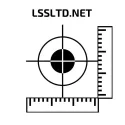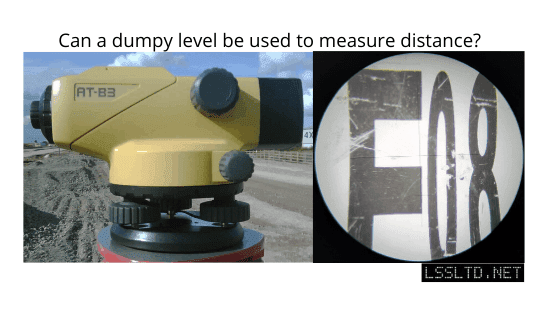Can a dumpy level really be used to measure distances?
Yes, it can. And in this article I shall be detailing how this can be done.
How to use a dumpy level to measure distance.
A little-known trick that can be done with automatic (dumpy) levels is to measure distances. This is done by using the Stadia Lines seen through the telescope of the automatic (dumpy) level to measure a distance from the automatic (dumpy) level.
What are Stadia Lines?
The Stadia Lines are two horizontal lines which are on the reticle, one above and one below the crosshairs seen through the telescope of an automatic (dumpy) level. These Stadia Lines are set at a specific distance apart so that a factor can be applied to observations to enable the calculation of a distance from the automatic (dumpy) level.
Why would you want to measure distances with a dumpy level?
Generally, surveyors and engineers would not use a dumpy level to measure distance. There are other tools that can be used to measure distances more accurately. However, one of the most important distance measurements that would be recorded by an automatic (dumpy) level would be when carrying out a two-peg test. Recording the upper and lower stadia readings will provide good information on the quality and the distance that the two-peg test was carried out over. Knowing how to measure distances using the stadia can be useful for setting up points that can be used for carrying out two-peg tests.
How to use a dumpy level to measure distance. The Stadia Method.
For this type of distance measurement to work properly, both the automatic (dumpy) level needs to be setup correctly and the E-Grad staff needs to be held plumb. To help with keeping the E-Grad Staff plumb I would recommend the use of a circular spirit vial like this one.
Sighting a vertical staff, take a reading at the upper stadia line and note it down. Take another reading at the lower stadia line and note it down. Calculate the difference between the two readings by taking the lower stadia reading away from the upper stadia reading. This figure needs to be multiplied by the stadia constant for your automatic (dumpy) level. Most automatic (dumpy) levels have a stadia ratio of 1:100.
Example of using a dumpy level to measure distance.
To show how this is done in practice, I have take a photo through the lens of my Topcon AT-B3 Automatic (Dumpy) Level that has been sighted on a well-used E-Grad Staff. I have set this up in the office so the distance measurement that will be calculated will be small.
In the photo, the upper stadia line reading is 841mm and the lower stadia line reading is 824mm. Knowing that the Stadia ratio for my Topcon AT-B3 is 1:100 the calculation for the distance between the automatic (dumpy) level and E-Grad staff is 1.700m.
The calculation is as follows: –
S = Upper Stadia Reading minus Lower Stadia Reading.
S = 841-824 = 17mm
D = kS
D = 100 x 17
D = 1700mm or 1.700m
How Accurate is the Distance Measurement When Using the Stadia Method?
I also measured this distance using my Leica Disto A5 to compare the results that I got using the Stadia Method. The distance measured with the Leica Disto A5 was 1.724m, you will have to believe me about this as I didn’t take any photos of this. This correlates well with the Stadia Method of distance measurement, but remember that when using this method you should only be accurate, at best, to 0.1 of a metre. This is because our Stadia Ratio is 1:100. So every mm seen between the Stadia Lines on the E-Grad Staff is worth 100mm in distance from the Automatic (Dumpy) Level.
If you want to know more about Laser Tape Measures like the Leica Disto, then have a look at the article on this site about Laser Tape Measures. There is also a section that shows how anyone can easily check their own laser tape measure.
The formula for Stadia Line Distance Measurement.
D=kS
D is the Distance from the automatic (dumpy) level to the E-Grad Staff.
K is the stadia constant (or Ratio). This is usually 100 (or 1:100).
S is the Upper Stadia reading minus the Lower Stadia reading.
Why are they called Stadia Marks?
Stadia Marks have their origins from a now obsolete measurement distance called the Stadion. It was a Greek unit of measurement that related to 600 Greek Feet, however there were differences in the length of the Greek Foot!!!
Do all automatic (dumpy) levels have Stadia Marks?
Not all automatic (dumpy) levels have Stadia Marks, but those that do invariably have them set at a Stadia Ratio of 1:100. It is the most basic automatic (dumpy) levels that do not have the Stadia Marks on the reticle.
Which automatic (dumpy) level is best?
There is not one specific automatic (dumpy) level that is the best. The best automatic (dumpy) level for you is dependent on what tasks are going to be undertaken and how much you are willing to spend. I would recommend that you would be best served by buying one of the top brands of automatic (dumpy) level. The brands I would recommend are Topcon or Leica. I have had a Topcon AT-B3 for about 10 years now and have never had any trouble with it. Here is a review about my Topcon AT-B3 on this website.
If you don’t want to spend a lot of money on a dumpy level then I have written an article detailing the best automatic (dumpy) levels for under £200.
Related Articles
How to Carry Out a Two-Peg Test
Quick and Easy Checks On Automatic (Dumpy) Levels
The Purpose and Importance of Levelling and the Automatic (Dumpy) Level.
Methods for Booking a Levelling Run. The Height of Collimation Method.
Methods for Booking a Levelling Run. The Rise and Fall Method.

